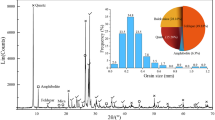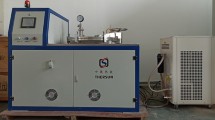Abstract
Mechanical excavation in hard or very hard rocks is still challenging in rock engineering. One plausible solution is to reduce rock strength prior to mechanical excavation to increase excavation and cost-efficiency. The present study utilizes a 6 kW microwave to irradiate rock specimens and evaluates the variation in rock strength and indentation hardness. Since the contact between the drill bits of roadheaders and the rock surface is a dynamic impact process, dynamic tests are conducted and compared with the quasi-static results. The experimental results demonstrate that short microwave irradiation (30 s) can produce substantial damage to the rock. The reduction of uniaxial compressive strength, Brazilian tensile strength, and indentation hardness under quasi-static loading can be about 39%, 43%, and 44%, respectively, and 33%, 26%, and 50%, respectively, under dynamic loading. In addition, it is found that the tensile strength is the most sensitive to microwave, while the crack density is the least sensitive. More importantly, this reduction is not linear and not monotonic to the irradiation time. The fast reduction of rock strength and indentation hardness after microwave irradiation implies the reduction in the drill-bit wear and increase in the excavation rate, and vigorously demonstrates the great potential of microwave-assisted mechanical excavation of hard or very hard rocks.
Highlights
-
The dynamic indentation test is used to simulate the impact between drill bits and rock surfaces.
-
Short microwave irradiation (30 s) can largely reduce the diorite strength and indentation hardness.
-
The reduction is not linear and not monotonic to the irradiation time, regardless of loading rates.
-
Different physical properties have different sensitivities to the microwave.
-
Experimental results demonstrate the great potential of the microwave technique in hard rock excavation.



















Similar content being viewed by others
Data availability statement
Readers are welcome to request source data obtained the present experiments.
References
Ataíde CH, Petri I Jr, dos Santos JM, Rossi AS, Pereira MS, Duarte CR (2017) Influence of rock chemical composition in microwave heating and decontamination of drill cuttings. Mater Sci Forum 899:469–473. https://doi.org/10.4028/www.scientific.net/MSF.899.469
Copur H, Balci C, Bilgin N, Tumac D, Avunduk E (2012) Predicting cutting performance of chisel tools by using physical and mechanical properties of natural stones. Paper presented at the ISRM International Symposium - EUROCK 2012, Stockholm, Sweden, 2012/5/28/
García R, Saavedra NF, Calderón-Carrillo Z, Mateus D (2008) Development of experimental correlations between indentation parameters and unconfined compressive strength (UCS) values in shale samples. CT&F - Ciencia, Tecnología y Futuro
Haftani M, Bohloli B, Moosavi M, Nouri A, Moradi M, Javan MRM (2013) A new method for correlating rock strength to indentation tests. J Petrol Sci Eng 112:24
Hartlieb P, Grafe B (2017) Experimental study on microwave assisted hard rock cutting of granite. BHM Berg- Huttenmann Monatsh 162:77–81. https://doi.org/10.1007/s00501-016-0569-0
Hartlieb P, Toifl M, Kuchar F, Meisels R, Antretter T (2016) Thermo-physical properties of selected hard rocks and their relation to microwave-assisted comminution. Miner Eng 91:34–41. https://doi.org/10.1016/j.mineng.2015.11.008
Hartlieb P, Grafe B, Shepel T, Malovyk A, Akbari B (2017) Experimental study on artificially induced crack patterns and their consequences on mechanical excavation processes. Int J Rock Mech Min Sci 100:160–169. https://doi.org/10.1016/j.ijrmms.2017.10.024
Hartlieb P, Kuchar F, Moser P, Kargl H, Restner U (2018) Reaction of different rock types to low-power (3.2 kW) microwave irradiation in a multimode cavity. Miner Eng 118:37–51. https://doi.org/10.1016/j.mineng.2018.01.003
Hassani F, Nekoovaght PM, Radziszewski P, Waters KE (2012) Microwave assisted mechanical rock breaking. Harmonising Rock Eng Environ. https://doi.org/10.1201/b11646-395
Hassani F, Nekoovaght PM, Gharib N (2016) The influence of microwave irradiation on rocks for microwave-assisted underground excavation. J Rock Mech Geotech Eng 8:1–15. https://doi.org/10.1016/j.jrmge.2015.10.004
Hassani F, Radziszewski P, Ouellet J, Nokkent M, Nekoovaght P (2008) Microwave assisted drilling and its influence on rock breakage a review. Paper presented at the ISRM International Symposium - 5th Asian Rock Mechanics Symposium, Tehran, Iran, 2008/1/1/
ISRM (1978) Suggested methods for determining tensile strength of rock materials. Int J Rock Mech Min Sci Geomech Abstracts 15:99–103. https://doi.org/10.1016/0148-9062(78)90003-7
Jerby E, Dikhtyar V, Aktushev O, Grosglick U (2002) The microwave drill. Science 298:587–589. https://doi.org/10.1126/science.1077062
Kahraman S et al (2022) The effect of mineralogy on the microwave assisted cutting of igneous rocks. Bull Eng Geol Environ 81:62. https://doi.org/10.1007/s10064-021-02561-3
Li X, Wang S, Xu Y, Yao W, Xia KW, Lu GM (2020) Effect of microwave irradiation on dynamic mode-I fracture parameters of Barre granite. Eng Fract Mech 224:12. https://doi.org/10.1016/j.engfracmech.2019.106748
Li X, Wang S, Xia K, Tong T (2021) Dynamic tensile response of a microwave damaged granitic rock. Exp Mech 61:461–468. https://doi.org/10.1007/s11340-020-00677-3
Lundberg B (1976) A split Hopkinson bar study of energy absorption in dynamic rock fragmentation. Int J Rock Mech Min Sci Geomech Abstracts 13:187–197. https://doi.org/10.1016/0148-9062(76)91285-7
Ma ZJ et al (2021) Design and performance of an open-ended converging microwave antenna in fracturing biotite diorite at low microwave power levels. Geomech Geophys Geo-Energy Geo-Resour 7:95. https://doi.org/10.1007/s40948-021-00291-0
Ma Z, Zheng Y, Zhao X, Li J (2022) Microwave-assisted hard rock breakage by impact hammers: heating, fracturing and mechanical breakage. Bull Eng Geol Environ 81:308. https://doi.org/10.1007/s10064-022-02808-7
Mardoukhi A, Hokka M, Kuokkala V-T (2018) Experimental study of the dynamic indentation damage in thermally shocked granite. Rakenteiden Mekaniikka 51:10–26. https://doi.org/10.23998/rm.69036
Nekoovaght P, Hassani F (2014) The influence of microwave radiation on hard rocks as in microwave assisted rock breakage applications. In: ISRM Regional Symposium - EUROCK 2014. ISRM-EUROCK-2014–027
Pressacco M, Kangas JJJ, Saksala T (2022) Numerical modelling of microwave heating assisted rock fracture. Rock Mech Rock Eng 55:481–503. https://doi.org/10.1007/s00603-021-02685-8
Qi Q, Guan W, Li X, Ge Y, Nan S, Liu H (2021) Mechanism of increasing the permeability of water-bearing coal rock by microwave steam explosion. Geofluids. https://doi.org/10.1155/2021/6661867
Qin L, Jun D, Yuan LQ (2015) Meso-mechanics simulation analysis of microwave-assisted mineral liberation. Frattura Ed Integrita Strutturale. https://doi.org/10.3221/igf-esis.34.60
Rafezi H, Deyab SM, Hassani F, Ghoreishi-Madiseh SA (2020) A comparative study of the cooling-rate effect on rock strength reduction after microwave irradiation. Exp Results 1:e36. https://doi.org/10.1017/exp.2020.32
Shamsi Armandi H, Jafari A, Gharibshahi R (2021) Nanoparticles assisted microwave radiation: Fluid-rock interactions in oil reservoirs. Pet Sci 18:1797–1812. https://doi.org/10.1016/j.petsci.2021.09.002
Shi X, Duan Y, Han B, Zhao J (2020) Enhanced rock breakage by pulsed laser induced cavitation bubbles: preliminary experimental observations and conclusions. Geomech Geophys Geo-Energy Geo-Resour 6:25. https://doi.org/10.1007/s40948-020-00143-3
Szwedzicki T (1998) Indentation hardness testing of rock. Int J Rock Mech Min Sci 35:825–829. https://doi.org/10.1016/S0148-9062(97)00334-3
Ulusay R (2015) The ISRM suggested methods for rock characterization, testing and monitoring: 2007–2014, 1st edn. Springer International Publishing, Cham (Imprint: Springer)
Wang ZG, Wei Z (2014) Theoretical analysis and simulation of microwave drill for rock. Adv Mater Res 962–965:886–889. https://doi.org/10.4028/www.scientific.net/AMR.962-965.886
Wang S, Xu Y, Xia K, Tong T (2021) Dynamic fragmentation of microwave irradiated rock. J Rock Mech Geotech Eng 13:300–310. https://doi.org/10.1016/j.jrmge.2020.09.003
Wang HC, Rezaee R, Saeedi A (2015) The interaction of reservoir properties and microwave heating an experimental and numerical modelling study of enhanced gas recovery (EGR). In: Drusa M, Marschalko M, Yilmaz I, Segallini A, Ferrero AM, Bednarik M (eds) World multidisciplinary earth sciences symposium, Wmess 2015, vol 15. Procedia Earth and Planetary Science. pp 542–548. https://doi.org/10.1016/j.proeps.2015.08.092
Wei W, Shao ZS, Zhang YY, Qiao RJ, Gao JP (2019) Fundamentals and applications of microwave energy in rock and concrete processing—a review. Appl Therm Eng 157:16. https://doi.org/10.1016/j.applthermaleng.2019.113751
Wong LNY, Zou C, Cheng Y (2014) Fracturing and failure behavior of carrara marble in quasistatic and dynamic Brazilian disc tests. Rock Mech Rock Eng 47:1117–1133. https://doi.org/10.1007/s00603-013-0465-9
Yao J, Tao M, Zhao R, Hashemi SS, Wang Y (2021) Effect of microwave treatment on thermal properties and structural degradation of red sandstone in rock excavation. Miner Eng 162:106730. https://doi.org/10.1016/j.mineng.2020.106730
Yu H, Li Y, Cui G, Elsworth D, Liu J, Liu M (2021) A model for focused-beam microwave heating on rock fracturing. Geomech Geophys Geo-Energy and Geo-Resour 7:40. https://doi.org/10.1007/s40948-021-00242-9
Zhao QH, Zhao XB, Zheng YL, Li JC, He L, He JL, Zou CJ (2020) Heating characteristics of igneous rock-forming minerals under microwave irradiation. Int J Rock Mech Min Sci 135:104519. https://doi.org/10.1016/j.ijrmms.2020.104519
Zheng YL, Ma ZJ, Zhao XB, He L (2020a) Experimental investigation on the thermal, mechanical and cracking behaviours of three igneous rocks under microwave treatment. Rock Mech Rock Eng 53:3657–3671. https://doi.org/10.1007/s00603-020-02135-x
Zheng YL, Zhao XB, Zhao QH, Li JC, Zhang QB (2020b) Dielectric properties of hard rock minerals and implications for microwave-assisted rock fracturing. Geomech Geophys Geo-Energy Geo-Resour 6:17. https://doi.org/10.1007/s40948-020-00147-z
Zheng YL, Ma ZJ, Yang SQ, Zhao XB, He L, Li JC (2021) A microwave fracturability index (MFI) of hard igneous rocks. Int J Rock Mech Min Sci 138:104566. https://doi.org/10.1016/j.ijrmms.2020.104566
Zou C, Li H (2021) Combined numerical and experimental studies on the dynamic and quasi-static failure modes of brittle rock. Int J Rock Mech Min Sci 148:104957. https://doi.org/10.1016/j.ijrmms.2021.104957
Zou C, Wong LNY (2016) Size and geometry effects on the mechanical properties of carrara marble under dynamic loadings. Rock Mech Rock Eng 49:1695–1708. https://doi.org/10.1007/s00603-015-0899-3
Zou C, Cheng Y, Li J (2021a) Strain rate and size effects on the brittleness indexes of Carrara marble. Int J Rock Mech Min Sci (oxford, England: 1997). https://doi.org/10.1016/j.ijrmms.2021.104860
Zou C, Li J, Zhao X, Zhao J (2021b) Why are tensile cracks suppressed under dynamic loading?—Transition strain rate for failure mode. Extreme Mech Lett. https://doi.org/10.1016/j.eml.2021.101506
Zou C, Maruvanchery V, Zhao X, He L (2021c) Change of crack mode in rock cracking process under quasi-static and dynamic loadings. Geomech Geophys Geo-Energy Geo-Resour 8:20. https://doi.org/10.1007/s40948-021-00313-x
Acknowledgements
The authors are grateful for the assistance and the data processing suggestions provided by the team member Dr. Gonglinan Wu and Mr. Zhijie Wang from Monash University, and Mr. Shuo Yang from Nanjing University. This work is supported by the National Natural Science Foundation of China (Grant Nos. 41831281, 52104121), the Innovative and Entrepreneurial Team Program of Jiangsu Province, China (JSSCTD202140), and the State Key Laboratory for GeoMechanics and Deep Underground Engineering, China University of Mining & Technology (SKLGDUEK2115).
Author information
Authors and Affiliations
Corresponding author
Additional information
Publisher's Note
Springer Nature remains neutral with regard to jurisdictional claims in published maps and institutional affiliations.
Rights and permissions
Springer Nature or its licensor (e.g. a society or other partner) holds exclusive rights to this article under a publishing agreement with the author(s) or other rightsholder(s); author self-archiving of the accepted manuscript version of this article is solely governed by the terms of such publishing agreement and applicable law.
About this article
Cite this article
Zou, C., Quan, X., Ma, Z. et al. Dynamic Strength and Indentation Hardness of a Hard Rock Treated by Microwave and the Influence on Excavation Rate. Rock Mech Rock Eng 56, 4535–4555 (2023). https://doi.org/10.1007/s00603-023-03243-0
Received:
Accepted:
Published:
Issue Date:
DOI: https://doi.org/10.1007/s00603-023-03243-0




